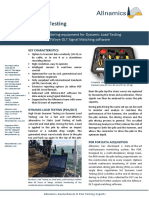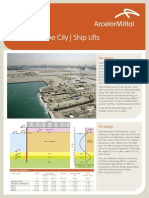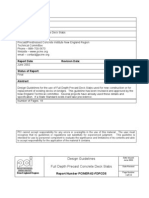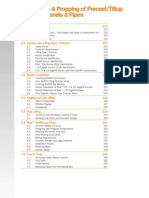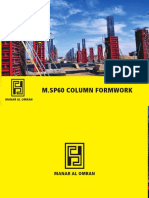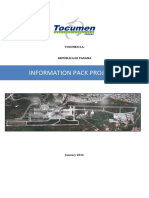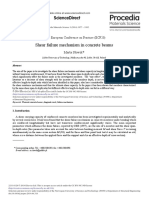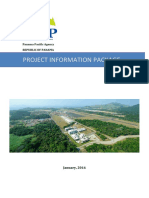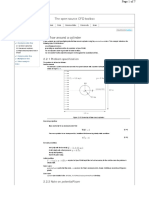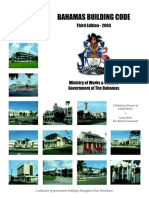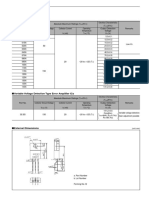X Block
Uploaded by
Anand JadoenathmisierX Block
Uploaded by
Anand JadoenathmisierInternet Calculator Concept Design
October 27, 2017
Internet Calculator
xbloc@xbloc.com
Concept Design
Calculator Input
Thank you for choosing the DMC Xbloc Calculator for determining the required Xbloc size for your breakwater
and/or revetment project. To calculate the required Xbloc size for the Xbloc armour layer various factors that
affect the design have to be taken into account. These factors are used as input for the calculator which then
calculates the required minimum theoretical Xbloc size. The minimum required theoretical Xbloc size is
rounded off to come up with an Xbloc standard size.
Please find in Table 1 the input parameters with which the calculation was executed. In Figure 1 a typical
cross-section of a breakwater is given in which the input parameters are indicated.
Table 1: Input Parameters
Parameters Parameter Value Unit
1 Section type Trunk section
2 Armour slope 3:4
3 Concrete density 2400 kg/m3
4 Water density 1030 kg/m3
5 Hs 1 year 1 m
6 Design wave height 3 m
7 Seabed slope 2 %
8 Toe level -1 m
9 Crest level 5 m
10 Seabed level at toe -1 m
11 Design high water level 3.5 m
12 Core permeability Fine core with geotextile
Figure 1: Typical cross-section
October 27, 2017
2/8
Internet Calculator
xbloc@xbloc.com
Concept Design
Calculator Output
From the input parameters output values are determined by the calculator.
In Table 2 the output values are given. The correction factors together with the applied factor used in the
calculation are shown in Table 3. Please note that the results generated by the online calculator are still only
indicative and should only be used as an initial approach. After a design is made physical model tests are
always recommended by DMC to verify the stability of the design.
Table 2: Output values
Parameters Parameter Value Unit
1 Theoretical volume 1.08 m3
2 Standard volume 1.00 m3
3 Unit mass 2.4 t
4 Unit height 1.44 m
5 Armour thickness 1.4 m
6 Concrete volume 0.58 m3/m2
7 Rock grading under layer 0.06 - 0.3 t
8 Thickness under layer 0.8 m
9 Packing density 57.81 Xblocs/100m2
10 Number of rows 8
Table 3: Correction factors
Correction factors Parameter Value
1 Frequent occurrence of near design wave height 1
2 Seabed slope 1
3 Low crested 1.5
4 Water depth / Hs 1
5 Core permeability 2
6 Armour slope 1
7 Applied factor 2
If assistance or advice is required for the design of a Xbloc breakwater and/or revetment do not hesitate to
contact DMC at:
xbloc@xbloc.com
dmc@dmc.nl
+31 182 590 610
October 27, 2017
3/8
Internet Calculator
xbloc@xbloc.com
Concept Design
Calculator Information
For the design of typical cross sections of breakwaters and shore protections, the required Xbloc size depends
on the design wave height and is determined with the Xbloc Calculator which is based on the following formula:
V Xbloc volume [m3]
Hs Design significant wave height [m]
V = [Hs / (2.77* )]3, where: Relative concrete density (c w)/w [-]
c Mass density of concrete [kg/m3]
w Mass density of water [kg/m3]
On a breakwater head or on a curved breakwater section, placement of the units is complicated by the
breakwater geometry. Furthermore the wave action can be affected by the geometry and as a consequence
the stability of the units is reduced. Therefore the weight of the Xblocs on a breakwater head or curved section
is increased by 25% compared to the unit mass on a straight section. Furthermore there are a number of
phenomena which require to further increase the Xbloc size. The phenomena and the correction factors on the
unit weight are as follows:
Phenomenon Effect on Armour stability Correction factor
Rocking of units, which can occur for a small
Frequent occurrence
percentage of the armour units during the design
of near design wave
event of a breakwater, can occur frequently during the 1.25
height during lifetime
lifetime of the structure. Therefore rocking should be
of the structure
carefully assessed during the physical model tests.
1.1 (between 1:30 and 1:20)
The foreshore in
A steep foreshore can lead to adverse wave impact 1.25 (between 1:20 and 1:15)
front of the structure
against the armour layer. 1.5 (between 1:15 and 1:10)
is steep
2.0 (greater than 1:10)
Armour units placed on the horizontal crest and high 2 for relative freeboard
The structure is low on the slope are less stable than units placed lower (=freeboard divided by the
crested on the slope, where interlocking is increased by design wave height)< 0.5
gravity and the above-lying units. 1.5 for relative freeboard < 1
For typical nearshore breakwater cross sections, the
ratio between the highest wave heights in the
spectrum and the significant wave height is in the
The water depth is order of 1.2 to 1.4. For breakwaters in the deep water, 1.5 for water depth > 2.5 x Hs
large this ratio can be up to 1.8 -2. As the largest waves in 2 for water depth > 3.5 x Hs
the spectrum cause the largest loads on the armour
layer, the stability of the armour layer is reduced
compared to breakwaters in lower water depths.
A low core permeability can lead to large pressures in
the armour layer and reduce the stability of the
The core armour layer. The permeability of the core depends 1.5 for low core permeability
permeability is low on the materials used and the distance at the water 2 for an impermeable core
line between the armour layer and the impermeable
layer.
On a mild slope, the interlocking of armour units is
The armour slope is 1.25 (slope milder than 2:3)
less effective and as a consequence the stability is
mild (<1:1.5) 1.5 (slope milder than 1:2)
reduced.
October 27, 2017
4/8
Internet Calculator
xbloc@xbloc.com
Concept Design
Calculator parameters
For the design of typical cross sections of breakwaters and shore protections, the required Xbloc size depends
on the design wave height, concrete and water density and other parameters like the armour slope and
seabed slope. The calculator uses these parameters to determine a theoretical Xbloc volume. The theoretical
Xbloc volume is then rounded off to a standard Xbloc size. Other parameters like freeboard, core permeability,
etc. affect the required size and thus have to be taken into account.
Table 4: Input parameters list
Parameters Parameter Unit Limit values
1 Section type - -
2 Armour slope - -
3 Concrete density kg/m3 2350 - 2500
4 Water density kg/m3 1000 - 1050
5 Hs 1 year m -
6 Design wave height m -
7 Seabed slope % 0 - 30
8 Toe level m Total height of structure cannot
9 Crest level m exceed 20 rows of Xblocs
10 Seabed level at toe m -
11 Design high water level m -
12 Core permeability - -
If the parameters as presented here above are outside the limits, please feel free to ask for advice from DMC:
dmc@dmc.nl or xbloc@xbloc.com.
Input parameters description
1. The calculation can be applied on two types of structure stretches: a trunk section or a non-linear section
(sharp bend or curve / roundhead section).
2. The calculator can consider armour slopes of 3:4, 2:3, 1:1.75, 1:2 and 1:2.25. Slopes milder than 2:3
require larger Xblocs.
3. The concrete density should not be overestimated in order to be lower than the minimum measured
density on site.
4. The water density is between 1000 to 1050 kg /m3.
5. The Hs 1 year is the significant wave height that can occur during a return period of 1 year.
6. The design wave height is the design significant wave height that can occur during the lifetime of the
structure. The ratio Hs 1 year / design wave height is a measure for the frequency of occurrence of the
near design wave height during the lifetime of the structure. If this ratio is larger than 0.8, a correction
factor of 1.25 is applied to the Xbloc weight.
7. The seabed slope is estimated taking into consideration the mean seabed slope in front of the structure.
8. The toe level is the level on which the first row of Xbloc or Xbase is placed.
9. The crest level is the top level of the Xbloc armour layer.
10. The Seabed level at the toe is the level on which the underlayer is placed for the Xbloc armour layer.
11. The design high water level is the highest water level that can occur during a return period of 100 year.
12. The core permeability has an influence on the wave induced forces on the Xbloc armour layer. An
October 27, 2017
5/8
Internet Calculator
xbloc@xbloc.com
Concept Design
impermeable core requires larger Xblocs.
October 27, 2017
6/8
Internet Calculator
xbloc@xbloc.com
Concept Design
Table 5: Output parameters list
Parameters Parameter Unit
1 Theoretical volume m3
2 Standard volume m3
3 Unit mass t
4 Unit height m
5 Armour thickness m
6 Concrete volume m3/m2
7 Rock grading under layer t
8 Thickness under layer m
9 Packing density Xblocs/100m2
10 Number of rows -
Output parameters description
1. The theoretical volume is the unit volume resulting from the calculator computation.
2. The standard volume is chosen from the standard sizes taken into account the theoretical volume needed.
3. The unit mass is calculated from the standard volume and the concrete density provided by the Designer.
4. The unit height is determined from the standard volume.
5. The armour thickness is related to the calculated standard volume.
6. The concrete volume is determined by the calculated standard volume and packing density. It is a
measure for how much volume of concrete is used for every square meter of Xbloc armour layer. The
concrete consumption per m2 is specified to Xbloc design standards.
7. The minimum required rock grading for the under layer of the calculated standard Xbloc size.
8. The under layer thickness is related to the under layer rock grading.
9. The number of units per 100 m2 is specified according to the standard volume determined by the
Calculator.
10. The number of rows is specified according to the standard volume determined by the Calculator, the toe
level, the crest level and the armour slope provided by the Designer.
For further information concerning input and output parameters, do not hesitate to contact DMC: dmc@dmc.nl
or xbloc@xbloc.com.
October 27, 2017
7/8
Internet Calculator
xbloc@xbloc.com
Concept Design
Conditions of Use of Xbloc Internet Calculator
Delta Marine Consultants [DMC] is a trademark of BAM Infraconsult B.V., a private company with limited
liability, with registered office at H.J. Nederhorststraat 1, Gouda, The Netherlands.
DMC is holder of several patents and patent applications in relation to the XBLOC Unit and the XBLOC Unit is
known and legally protected by the trademark XBLOC.
Client wishes to use DMCs Xbloc Internet Calculator on www.xbloc.com.
Client shall not use XBLOC without a signed Xbloc agreement between Client and DMC in place. The use of
XBLOC shall be carried out according to the XBLOC Specifications.
The following conditions apply to the use of the Xbloc Internet Calculator.
DMC shall exercise all reasonable skill, care and diligence in the performance of the Xbloc Internet
Calculator. The result of the Xbloc Internet Calculator is based on current professional insights. Changes
in these insights may lead to changes in DMCs advice.
DMC shall not be not liable for any direct and/or indirect or consequential damages or losses such as loss
of revenue, loss of profit, loss of anticipated profit, loss of use, production, product, productivity, facility
downtime and business opportunity resulting from the Xbloc Internet Calculator.
The advice provided by DMC is subject to confirmative physical model tests to be carried out by Client
prior to the use of XBLOC.
All information provided by DMC concerning (the application of) XBLOC is proprietary information of DMC.
It shall not be disclosed by Client to any third parties.
The relationship between Client and DMC shall be governed by the law of The Netherlands and any
disputes arising out of or in connection with the work carried out by DMC shall finally be settled by the
competent courts in The Hague.
October 27, 2017
8/8
You might also like
- 13 Years Test Experience With Short Circuit Withstand Capability of Large Power TransformersNo ratings yet13 Years Test Experience With Short Circuit Withstand Capability of Large Power Transformers7 pages
- Male Hulhule Bridge Feasibility Report Aug 2011 Final PDFNo ratings yetMale Hulhule Bridge Feasibility Report Aug 2011 Final PDF118 pages
- Male Hulhule Bridge Feasibility Report Aug 2011 Final PDFNo ratings yetMale Hulhule Bridge Feasibility Report Aug 2011 Final PDF118 pages
- Groynes in Coastal Engineering (C793) PDFNo ratings yetGroynes in Coastal Engineering (C793) PDF200 pages
- Clinical Applications: Syngo Vessel ViewNo ratings yetClinical Applications: Syngo Vessel View8 pages
- Internet Calculator Concept Design: April 3, 2016No ratings yetInternet Calculator Concept Design: April 3, 20167 pages
- Harbour Works (Break Water) 15. - 17.01.2023 PDFNo ratings yetHarbour Works (Break Water) 15. - 17.01.2023 PDF50 pages
- Design and Material Selection For Quality - Volume 1No ratings yetDesign and Material Selection For Quality - Volume 11 page
- Ballina Accropode Breakwater Flume Testing - Report Mhl795 - 00.03.1997 - Manly Hydraulics Lab - Dept ofNo ratings yetBallina Accropode Breakwater Flume Testing - Report Mhl795 - 00.03.1997 - Manly Hydraulics Lab - Dept of31 pages
- 02 - GRC Submitted - Drilling, Installation and Grouting MethodologyNo ratings yet02 - GRC Submitted - Drilling, Installation and Grouting Methodology33 pages
- Self-Taught Education Unit: Coastal Shoreline Defense StructuresNo ratings yetSelf-Taught Education Unit: Coastal Shoreline Defense Structures19 pages
- A Case Study of The New Breakwater of The Port of GenovaNo ratings yetA Case Study of The New Breakwater of The Port of Genova43 pages
- Crest Modifications To Reduce Wave OvertNo ratings yetCrest Modifications To Reduce Wave Overt20 pages
- RC Simple Notions of Moment DistributionNo ratings yetRC Simple Notions of Moment Distribution136 pages
- Efficiency of Container and Bulk Cargo PortsNo ratings yetEfficiency of Container and Bulk Cargo Ports46 pages
- Designing Steel Piles For Marine ApplicationsNo ratings yetDesigning Steel Piles For Marine Applications39 pages
- Engineering and Construction Standard: IPS-G-CE-470No ratings yetEngineering and Construction Standard: IPS-G-CE-47035 pages
- Van Der Meer - Design of Concrete Armour LayersNo ratings yetVan Der Meer - Design of Concrete Armour Layers11 pages
- Breakwater, Artificial Offshore Structure Protecting A: HarbourNo ratings yetBreakwater, Artificial Offshore Structure Protecting A: Harbour3 pages
- THE Design OF Upright Breakwaters: Depart - Ent of Civil Engineering Yokoha.a National University, Yokoha.a 240, JapanNo ratings yetTHE Design OF Upright Breakwaters: Depart - Ent of Civil Engineering Yokoha.a National University, Yokoha.a 240, Japan22 pages
- Chapter 10: Beaches, Shoreline Processes and The Coastal OceanNo ratings yetChapter 10: Beaches, Shoreline Processes and The Coastal Ocean82 pages
- Farm and Ranch Airstrips: How To Build Your Own Airstrip100% (1)Farm and Ranch Airstrips: How To Build Your Own Airstrip28 pages
- B1 XPMS Waiver Processing Training Notes 30-July-09No ratings yetB1 XPMS Waiver Processing Training Notes 30-July-0934 pages
- Port Designers Handbook Recommendations and Guidelines 224 240No ratings yetPort Designers Handbook Recommendations and Guidelines 224 24017 pages
- Technical Bulletin Spillways and Flood Control Structures PDFNo ratings yetTechnical Bulletin Spillways and Flood Control Structures PDF15 pages
- Diaphragm Wall Quays For Myanmar Mega-PortNo ratings yetDiaphragm Wall Quays For Myanmar Mega-Port3 pages
- Review of Design Method For Excavations-Hong Kong Ep1 - 90100% (1)Review of Design Method For Excavations-Hong Kong Ep1 - 90188 pages
- BAM Clough Brochure270313single PageswebNo ratings yetBAM Clough Brochure270313single Pagesweb6 pages
- Xbloc-Plus: The Interlocking, Pattern Placed & Efficient Armour UnitNo ratings yetXbloc-Plus: The Interlocking, Pattern Placed & Efficient Armour Unit1 page
- RTD 1016-1 Guidelines For Nonlinear Finite Element Analysis of Concrete StructuresNo ratings yetRTD 1016-1 Guidelines For Nonlinear Finite Element Analysis of Concrete Structures68 pages
- Tocumen SA - Project Profiles 2016-2017No ratings yetTocumen SA - Project Profiles 2016-201710 pages
- Shear Failure Mechanism in Concrete Beams: SciencedirectNo ratings yetShear Failure Mechanism in Concrete Beams: Sciencedirect6 pages
- Hydraulic Structures: Lecture Notes CT3330No ratings yetHydraulic Structures: Lecture Notes CT3330121 pages
- 2.2 Flow Around A Cylinder: The Open Source CFD ToolboxNo ratings yet2.2 Flow Around A Cylinder: The Open Source CFD Toolbox7 pages
- Manual Hydraulic Structures CTB3355 Constructieve WaterbouwNo ratings yetManual Hydraulic Structures CTB3355 Constructieve Waterbouw351 pages
- Manual Hydraulic Structures CTB3355 Constructieve WaterbouwNo ratings yetManual Hydraulic Structures CTB3355 Constructieve Waterbouw351 pages
- AC 14002 Flight Dispatcher Training and Approval20200814 FinalNo ratings yetAC 14002 Flight Dispatcher Training and Approval20200814 Final32 pages
- Practical A5 Stoke' S Law and Viscosity of Oil.No ratings yetPractical A5 Stoke' S Law and Viscosity of Oil.7 pages
- CLT South Africa Xlam Brochure-Version-2.0No ratings yetCLT South Africa Xlam Brochure-Version-2.010 pages
- Chapter 22: Current and Resistance: SolutionsNo ratings yetChapter 22: Current and Resistance: Solutions5 pages
- 13 Years Test Experience With Short Circuit Withstand Capability of Large Power Transformers13 Years Test Experience With Short Circuit Withstand Capability of Large Power Transformers
- Male Hulhule Bridge Feasibility Report Aug 2011 Final PDFMale Hulhule Bridge Feasibility Report Aug 2011 Final PDF
- Male Hulhule Bridge Feasibility Report Aug 2011 Final PDFMale Hulhule Bridge Feasibility Report Aug 2011 Final PDF
- Design and Material Selection For Quality - Volume 1Design and Material Selection For Quality - Volume 1
- Ballina Accropode Breakwater Flume Testing - Report Mhl795 - 00.03.1997 - Manly Hydraulics Lab - Dept ofBallina Accropode Breakwater Flume Testing - Report Mhl795 - 00.03.1997 - Manly Hydraulics Lab - Dept of
- 02 - GRC Submitted - Drilling, Installation and Grouting Methodology02 - GRC Submitted - Drilling, Installation and Grouting Methodology
- Self-Taught Education Unit: Coastal Shoreline Defense StructuresSelf-Taught Education Unit: Coastal Shoreline Defense Structures
- A Case Study of The New Breakwater of The Port of GenovaA Case Study of The New Breakwater of The Port of Genova
- Engineering and Construction Standard: IPS-G-CE-470Engineering and Construction Standard: IPS-G-CE-470
- Breakwater, Artificial Offshore Structure Protecting A: HarbourBreakwater, Artificial Offshore Structure Protecting A: Harbour
- THE Design OF Upright Breakwaters: Depart - Ent of Civil Engineering Yokoha.a National University, Yokoha.a 240, JapanTHE Design OF Upright Breakwaters: Depart - Ent of Civil Engineering Yokoha.a National University, Yokoha.a 240, Japan
- Chapter 10: Beaches, Shoreline Processes and The Coastal OceanChapter 10: Beaches, Shoreline Processes and The Coastal Ocean
- Farm and Ranch Airstrips: How To Build Your Own AirstripFarm and Ranch Airstrips: How To Build Your Own Airstrip
- B1 XPMS Waiver Processing Training Notes 30-July-09B1 XPMS Waiver Processing Training Notes 30-July-09
- Port Designers Handbook Recommendations and Guidelines 224 240Port Designers Handbook Recommendations and Guidelines 224 240
- Technical Bulletin Spillways and Flood Control Structures PDFTechnical Bulletin Spillways and Flood Control Structures PDF
- Review of Design Method For Excavations-Hong Kong Ep1 - 90Review of Design Method For Excavations-Hong Kong Ep1 - 90
- Xbloc-Plus: The Interlocking, Pattern Placed & Efficient Armour UnitXbloc-Plus: The Interlocking, Pattern Placed & Efficient Armour Unit
- RTD 1016-1 Guidelines For Nonlinear Finite Element Analysis of Concrete StructuresRTD 1016-1 Guidelines For Nonlinear Finite Element Analysis of Concrete Structures
- Shear Failure Mechanism in Concrete Beams: SciencedirectShear Failure Mechanism in Concrete Beams: Sciencedirect
- 2.2 Flow Around A Cylinder: The Open Source CFD Toolbox2.2 Flow Around A Cylinder: The Open Source CFD Toolbox
- Manual Hydraulic Structures CTB3355 Constructieve WaterbouwManual Hydraulic Structures CTB3355 Constructieve Waterbouw
- Manual Hydraulic Structures CTB3355 Constructieve WaterbouwManual Hydraulic Structures CTB3355 Constructieve Waterbouw
- AC 14002 Flight Dispatcher Training and Approval20200814 FinalAC 14002 Flight Dispatcher Training and Approval20200814 Final


